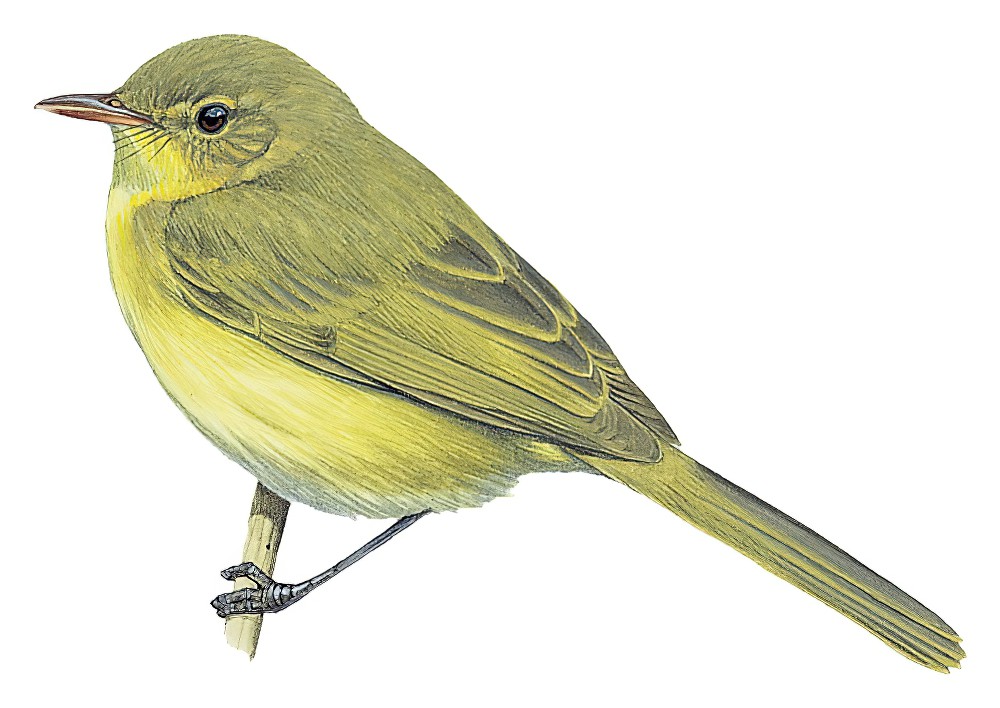Mountain Yellow-Warbler / Iduna similis

Mountain Yellow-Warbler
SCI Name:
Protonym: Chloropeta similis Auk 14 p.163
Taxonomy: Passeriformes / Acrocephalidae / Iduna
Taxonomy Code: moywar1
Type Locality: Mt. Kilimanjaro, Tanganyika; altitude 10,000 feet.
Author: Richmond
Publish Year: 1897
IUCN Status: Least Concern
DEFINITIONS
IDUNA
(Acrocephalidae; Ϯ Booted Warbler I. caligata) Norse myth. Iðunn or Iduna, goddess of spring and fertility, keeper of the magic apples of rejuvenation, who was changed into a sparrow to enable her rescue by Loki, in falcon form, from the giant Þjazi or Thiassi (Raul Mohedano in litt.); "IDUNA: 235. L. CALIGATA Lichtenst. — Sylvia caligata Licht. in Eversm. Reise p. 128. — Motacilla Salicaria Pall. Zoogr. I. p. 492. n. 127. In Russland und Sibirien strichweise in Weidengebüschen an Flüssen hin, so weit strauchartige Gewächse gedeihen, auch in Daurien beobachtet, von EVERSMANN am Ilek, einem Nebenflusse des Ural angetroffen." (von Keyserling & Blasius 1840); "Iduna Keyserling and J. H. Blasius, 1840, Wirbelthiere Europa's, p. 58. Type, by monotypy, Sylvia caligata Lichtenstein." (Watson in Peters 1986, XI, 78).
Synon. Chloropeta, Jerdonia, Psaltria.
simile / similis
L. similis, simile similar, resembling. Indicating a similarity in appearance or affinity to another, usually congeneric, species. Over thirty forms share this epithet; some are shown below.
● "193.—A. similis.—New species?—Large Titlark. Descr.—The description of the last species [A. rufula] will apply exactly to this very similar bird, with this exception, that the centre markings of the feathers are still more indistinct in this one; and that the fawn colour of the plumage beneath, extends over all the abdomen, vent, and under tail coverts. It differs, however, remarkably in size and in some points of structure." (Jerdon 1840) (Anthus).
● "PTILOTIS PROCERIOR, F. & H., is unknown in Taviuni; and its place is supplied by a species that I at first took for P. carunculata, Gmel. But the more I look at it, the more I doubt its identity with that bird; without actual comparisons, however, with specimens from Tonga, which is, I believe, the real habitat of P. carunculata, I cannot quite decide the point. Measurements go for little in this species, hardly two individuals agreeing together; but not a single specimen we procured has the bill as short as 8'", the maximum quoted by Drs. Finsch and Hartlaub. Then, again, they describe the iris as "white," and so figure it; in ours they are all buff, a darker shade prevailing. The wattle is very different from that of P. procerior, but hardly resembles that figured by Drs. Finsch and Hartlaub. If found distinct on actual comparison, I would name it P. similis. I would call it after the island, of the birds of which I now write; but I possess some specimens from Bua and Mathuata islands which are identical." (Layard 1876) (syn. Foulehaio taviunensis).
● "32. LE PIC SEMBLABLE. (Picus similis, Lesson.) ... Celui que nous décrivons ici, et que nous adressons à M. Malherbe, pour sa belle Monographie des pics, ressemble singulièrement au lineatus, à l'erythrocephalus et à l'anaïs, et cependant, en le comparant à ces trois espèces, il offre des dissemblances." (Lesson 1847) (subsp. Hylatomus lineatus).
● "9. Chloropeta similis, new species. ... Its nearest relative appears to be C. icterina, but from this it differs in the wing formula, in smaller size, and apparently in the color of the thighs and upper parts." (Richmond 1897) (Iduna).
● "MONASA SIMILIS, new species. Cerro Azul Nun Bird. ... In general coloration very similar to M. fidelis from the same locality but immediately distinguishable by absence of white on chin, this color being confined to a band about base of upper mandible extending to lores as in pallescens" (Nelson 1912) (syn. Monasa morphoeus fidelis).
● "SPECIES 14. MUSCICAPA SIMILIS. TAB. XXV. Mediocris, supra olivaceo-fusca, subtus sulphurea, Muscicapae cayennensi simillima, diversa vero rostro brevi, capite non nigro sed fusco, verticeque non flavo sed aurantio." (von Spix 1825) (Myiozetetes).
● "PETROICA SIMILIS. ... Very like Petroica pusilla of Peale, from Navigators' Islands, but it is larger (being 4½" in length), with the throat varied with white, scarlet, and fuscous-black; the outer tail-feathers white, with a blackish spot near the apex, and the outer margin only of the second feather white. New Hebrides (Aneiteum)." (G. Gray 1860) (subsp. Petroica pusilla).
● "5. S. similis, Nob. ... differt a Tanagra magna, Gmel., Saltatore olivaceo, Vieillot, t. 4, p. 108, cui affinis tergo caudaque non viridibus, vitta superciliari post oculum ad nucham protensa, in Tanagra magna, ante oculari tantummodo juguloque non ferrugineo." (de La Fresnaye & d'Orbigny 1837) (Saltator).
UPPERCASE: current genus
Uppercase first letter: generic synonym
● and ● See: generic homonyms
lowercase: species and subspecies
●: early names, variants, mispellings
‡: extinct
†: type species
Gr.: ancient Greek
L.: Latin
<: derived from
syn: synonym of
/: separates historical and modern geographic names
ex: based on
TL: type locality
OD: original diagnosis (genus) or original description (species)












